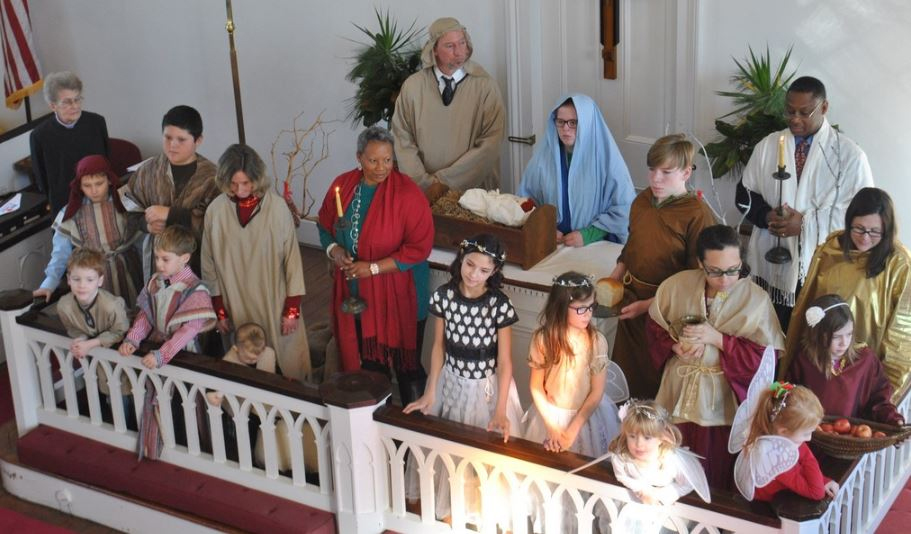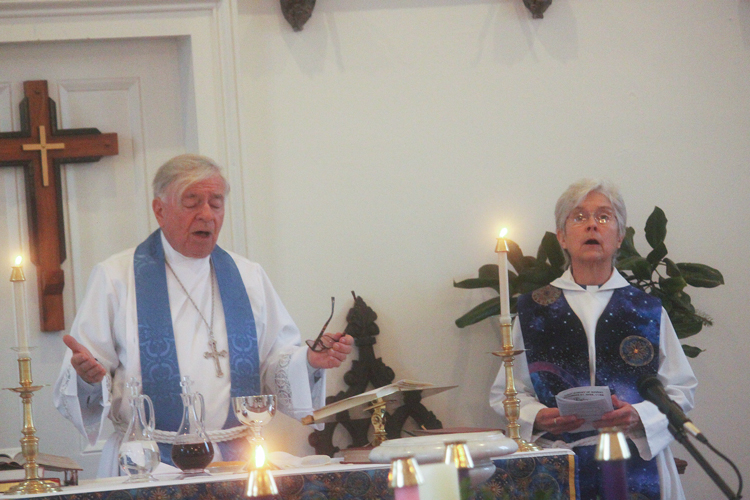Looking at Sin, repentance and Judgement – From Ruth Frey- Trinity Episcopal NY
Matthew’s vision of Jesus’s arrival doesn’t mesh well with our conventional view of the coming of Christmas. No angels or songs here. Instead, we get a strangely dressed man in the wilderness talking about sin, repentance, and fire and calling some people vipers. Definitely not a story that fits into the chatter of a typical holiday party. Yet, John the Baptist is the entry point to meeting Jesus, who declares the reign of God.
Sin, repentance, and judgement carry a lot of negative weight for humans living in today’s world with emotions of shame, guilt, and condemnation following close behind. But what if we considered sin as a matter of how we relate to what we have — be it power, resources, or material goods?
What if we saw repentance as the correcting response when we use our power, resources, and material goods in ways that do not benefit, but rather hurt, our neighbor and the earth?
And maybe being called into judgement is a call to see the world as it really is, in all its glory and pain, and to be given another chance to respond to it all with love.
Prepare the Way – Karen Hanson
When I imagine John the Baptist urging people to prepare the way of the Lord, I think of my time as a trauma chaplain in a busy safety-net hospital in Minneapolis. It was important to have a direct path from the ambulance bay to the Stabilization Room so that our critical trauma patients could be quickly transported to life-sustaining help.
At that time the paramedics had a few corners to turn and occasionally an obstacle that had to be removed in order to get the patient where they needed to go. Years later, a redesign of the Emergency Department created a beeline straight to the Stabilization Room. It’s almost as if the planners took that Isaiah passage echoed by the Baptist literally: remove the obstacles, make the path straight, and the rough smooth so that people might be delivered from death and set on a healing path.
Christians think too small in Advent. It’s not primarily individual work that needs doing. It is not a time of exclusively private reflection. The coming of the Lord is always happening and requires lots of heavy lifting. As forgiven and free people of God in Christ, Christians are called to do the work of removing obstacles that keep people from the full, liberating deliverance of God. They are to level the hills and fill in the valleys so that everyone is on an equal footing. They are to remove any system, stumbling stone, or barrier that hinders the return. This is what it means to prepare the way of the Lord.
Contemporary Christians who seek to follow this Lord have strayed from the way of Christ if they only feed the hungry and house the homeless. These acts may save lives but they don’t transform. The way of the Lord changed the captives into the homeward bound. Jesus’ good news to the poor was intended to upend the systems of oppression that the rich have always exacted on the lowly, among them the behemoth of advanced capitalism in our present day. Preparing the way of the Lord is not just a private, individual matter. It is world-changing and rallies everyone to be involved. As Mary proclaims in the Magnificat, “He has brought down the powerful from their thrones, and lifted up the lowly” (Luke 1:52).
Preparing the way of the Lord is urgent work for Christians here and now, for there are many wounded, lowly, grieving, dying, and exiled people that need a level path to get the help they need. Preparing the way of the Lord isn’t a past event; it is ongoing. The Way is made as people walk it together.
Prepare the Way
Looking at Sin by Debie Thomas
John’s gaunt austerity is the only gateway we have to the swaddling clothes, angel’s wings, and fleecy lambs we hold dear each December. As baffling as it may seem, the holy drama of the season depends on the disheveled baptizer’s opening act. So again, why the wilderness?
For starters, because the wilderness is a place of vulnerability, risk, and powerlessness. In the wilderness, we have no safety net. To locate ourselves at the outskirts of security and power is to confess our neediness in the starkest terms. In the wilderness, we have no choice but to wait and watch as if our lives depend on God showing up. Because they do. And it’s into such an environment — an environment so far removed from safety as to make safety laughable — that the word of God comes.
“Sin.” We associate it with shame, guilt, and condemnation.
Advent begins with an honest, wilderness-style reckoning with sin. We can’t get to the manger unless we go through John, and John is all about repentance. Is it possible that this might become an occasion for relief? Maybe, if we can get past our baggage and follow John out into the wilderness, we will find comfort in the fact that something more profound is at stake in our souls than, “I make mistakes sometimes,” or “I’ve got a few issues.” What ails is something deeper, grimmer, and far more consequential.
Sin, at its heart, is a refusal to become fully human. It’s anything that interferes with the opening up of our whole hearts to God, to others, to creation, and to ourselves. Sin is estrangement, disconnection, sterility, disharmony. It’s the sludge that slows us down, that says, “Quit. Stop trying. Give up. Change is impossible.”
Sin is apathy. Care-less-ness. A frightened resistance to an engaged life. Sin is the opposite of creativity, the opposite of abundance, the opposite of flourishing. Sin is a walking death. And it is easier to spot, name, and confess a walking death in the wilderness than it is anywhere else.
John underscores his message of repentance with a harrowing description of the coming Messiah
I wonder if we squirm because we misconstrue the meaning of judgment. I tend to equate judgment with condemnation, but in fact, to judge something is to see it clearly — to know it as it truly is. In my dictionary, synonyms for judgment include discernment, acuity, sharpness, and perception.
What if John is saying that the Messiah who is coming really sees us? That he knows us at our very core? Maybe the winnowing fork is an instrument of deep love, patiently wielded by the One who discerns in us rich harvests still hidden by chaff. Maybe it’s in offering God every particular of our lives that we give Him permission to “clear” us — to separate all that’s destructive from all that is good, beautiful, and worthy.
Finally, Matthew suggests that the wilderness is a place where we can see the landscape whole, and participate in God’s great work of leveling inequality and oppression.
Unless we’re in the wilderness, it’s hard to see our own privilege, and even harder to imagine giving it up. No one standing on a mountaintop wants the mountain flattened. But when we’re wandering in the wilderness, and immense, barren landscapes stretch out before us in every direction, we’re able to see what privileged locations obscure. Suddenly, we feel the rough places beneath our feet. We experience what it’s like to struggle down twisty, crooked paths. We glimpse arrogance in the mountains and desolation in the valleys, and we begin to dream God’s dream of a wholly reimagined landscape. A landscape so smooth and straight, it enables “all flesh” to see the salvation of God.
Where are you located during this Advent season? How close are you to security and power, and how open are you to risking the wilderness to hear a word from God? What might repentance look like for you, here and now? Where is God leveling the ground you stand on, and what will it take for you to participate in that uncomfortable but essential work?
Debie Thomas: The Voice of One Crying
https://www.journeywithjesus.net/essays/2470-the-voice-of-one-crying







 READ!
READ! WATCH
WATCH LEARN!
LEARN! LISTEN!
LISTEN! PRAY AND REFLECT!
PRAY AND REFLECT! MAKE!
MAKE!
